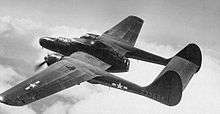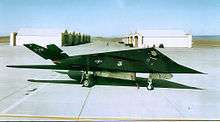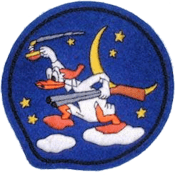415th Special Operations Squadron
| 415th Special Operations Squadron | |
|---|---|
| Active | 1943–Present |
| Country |
|
| Branch |
|
| Type | Squadron |
| Role | Special Operations Training |
| Part of | 58th Operations Group |
| Garrison/HQ | Kirtland AFB, New Mexico |
| Engagements |
World War II (EAME Theater) 1991 Gulf War (Defense of Saudi Arabia; Liberation of Kuwait) |
| Decorations |
Air Force Outstanding Unit Award (2x) |
| Insignia | |
| 415th Tactical Fighter Squadron emblem |
 |
The 415th Special Operations Squadron is a United States Air Force unit. It is assigned to the 58th Operations Group, assigned to Kirtland Air Force Base, New Mexico.
The 415th Night Fighter Squadron was formed in February 1943 and it carried out patrols in the Mediterranean and then North-west Europe during World War II. It was inactivated in 1947 with its personnel and aircraft transferred to another squadron.
Re-activated in 2011, the squadron replaced the 58th Special Operations Wing Detachment 1. Its mission is to train special operations personnel operating both the HC-130J Combat King II and the MC-130J Commando II.
History
World War II
During World War II, the 415th Night Fighter Squadron was activated on 10 February 1943. At that time, the squadron was assigned to the Army Air Forces School of Applied Tactics for training in the P-70 fighter, a converted A-20 Havoc light bomber. That training included daylight and night air interception, ground-controlled interception, navigation, and instrument flying.[1]
On 3 March 1943, an air echelon from the unit left Florida. Twenty days later, the echelon sailed on the vessel Empress of Scotland and arrived in England on the 31st. There, the pilots, engineers, and radar operators trained separately until May 1943, when all elements of the air echelon moved to RAF Ayr, Scotland, for training as a complete unit. The ground element moved from Florida on 22 April 1943 to Camp Kilmer, New Jersey, and left there a week later on the U.S. Army Transport Shawnee for North Africa. They arrived at Oran, Algeria on 11 May 1943 to begin working and training at the nearby Oran Es Sénia Airport. In June 1943, the ground element moved to Tunisia, where it worked with a Royal Air Force night fighter squadron. The air echelon joined the ground troops in early July at Monastir, Tunisia.[1]

The 415th entered combat as a unit in July 1943, flying the British-made Bristol Beaufighter aircraft. Unit pilots flew convoy patrols, night patrols, and intercept scrambles. As its first important mission, the 415th flew escort duty for the airborne invasion of Sicily in July 1943. The unit moved to Sicily in early September, and later to Italy in December as the allies continued gain on Axis forces. In Italy, the squadron continued its patrols and even flew cover over the Anzio beachhead during January and February 1944.[1]
In July 1944, the unit moved again to Corsica to take part in the pending Invasion of Southern France. That invasion occurred in August; the 415th again flew night patrols covering the beachheads. After the allied ground forces established beachheads, the squadron actually moved into France, where it supported the American 7th and French 1st Armies with night interception and night intruder sorties. The pilots also patrolled the lines at St. Die and dropped flares to light up targets for the artillery. Through April 1945, the squadron flew patrols and intruder missions, concentrating its attacks on enemy installations, supplies, communications, and troops.[1]
The 415th took part in the Western Allied invasion of Germany, moving to Braunstadt, Germany, where it transitioned from the Beaufighter to the American night fighter, the P-61 Black Widow. The squadron, however, only flew a few missions in this new aircraft before the war ended. With the fall of Germany, the unit became part of the United States Air Forces in Europe army of occupation. It was assigned to AAF Station Nordholz, Germany in October 1945, remaining until February 1946 when it returned to the United States.[1]
Postwar Era
Arriving at Bolling Field, Washington, D.C., the squadron returned without people and equipment, and then to Shaw Field, South Carolina. The unit remained unmanned through July 1946 when new people with P-61s and B-25s arrived. It resumed its training in night fighter techniques until May 1947, when the squadron was reassigned to Alaskan Air Command, being stationed at Adak Army Airfield in the Aleutian Islands to defend the Aleutian island chain. It flew training patrols until being inactivated on 1 September 1947, with its personnel and aircraft being assigned to the 449th Fighter Squadron (All Weather) upon inactivation.[1]
Special Operations
During the final phases of the War in Southeast Asia, the 415th was re-designated the 415th Special Operations Training Squadron, as a component of the 1st Special Operations Wing to replace the 4413th Combat Crew Training Squadron.[1]
There, the squadron provided special operations combat training for aircrews in the AC-119G Shadow gunship. In early 1971, the unit additionally acquired AC-130H Spectre gunships. It moved to Hurlbert Field, Florida, in July 1971 to continue special operations training. At this station, the 415th also gave numerous displays and firepower demonstrations of its capabilities. In October 1972, the squadron transferred its AC-119s to the South Vietnamese Air Force; however, the 415th continued its training mission until 30 June 1975 when it inactivated a second time.[1]
F-117 Development/Operations
Activated by Tactical Air Command at Groom Lake, Nevada as a classified unit on 11 July 1981, designated as I-Unit. Began receiving Full-Scale Development (FSD) F-117A stealth fighters from Lockheed for testing. Was moved to Tonopah Test Range Airport on 28 October 1983, being re-designated as the 4450th Tactical Squadron as part of the 4450th Tactical Group performing training missions with the F-117A in a clandestine environment. All Tonopah training flights conducted at night under the cover of darkness until late 1988. On 10 November 1988, the Air Force brought the F-117A from behind a "black veil" by publicly acknowledging its existence, but provided few details about it. The official confirmation of the F-117A's existence, however, had little impact on Tonopah operations. Pilots began occasionally flying the F-117A during the day, but personnel were still ferried to and from work each Monday and Friday from Nellis. Everyone associated with the project was still forbidden to talk about what they did for a living, and the program remained shrouded in secrecy.[2]
The 4450th Tactical Group was inactivated on 5 October 1989, the squadron being re-designated as the 415th Tactical Fighter Squadron under the 37th Tactical Fighter Wing and become one of two operational F-117A Stealth Fighter squadrons.[1]


On 19 December 1989, just over two months after being reactivated, the F-117 was deployed into combat for the first time. This was in Operation Just Cause, the invasion of Panama intended to dislodge and arrest General Manuel Noriega. At the beginning of the invasion, six F-117As flew to Panama from Tonopah. Their mission was to drop 2000-pound bombs near the Panama Defense Forces (PDF) barracks at Rio Hato. The purpose of these bomb drops was to stun and disorient the PDF troops living there so that the barracks could be stormed and the troops captured with minimal resistance and casualties. The pilots were instructed to drop their bombs no closer than 50 meters from two separate PDF barracks buildings. On the night of 19 December, two lead F-117As each dropped a conventional 2000-pound bomb at the Rio Hato barracks.[3]
Less than a year later, in response to the Iraqi invasion of Kuwait on 2 August 1990, the 415th TFS was deployed to King Khalid International Airport, Saudi Arabia on 19 August 1990. On 17 January 1991, the Coalition began an air offensive to eject Iraqi troops from Kuwait. In the early morning hours, the F-117As of the 37th TFW initiated the air war against Iraq. Mission planners had assigned critical strategic Iraqi command and control installations to the F-117A, counting on the aircraft's ability to hit precisely at well-defended targets without being seen. Other vital targets included key communications centers, research and development facilities for nuclear and chemical weapons, plus hardened aircraft shelters on Iraqi airfields. On the first night of the war, an F-117A dropped a 2000-pound laser-guided GBU-27 Paveway III bomb right through the roof of the general communications building in downtown Baghdad. In another attack on the communications building next to the Tigris River, another GBU-27 Paveway III was dropped through an air shaft in the center of the roof atop the building and blew out all four walls. During the first three weeks of the air offensive, F-117As obliterated many hardened targets with unprecedented precision. The 37th TFW flew 1271 combat sorties and maintained an 85.5 percent mission-capable rate. The 43 F-117As of the 37th TFW dropped more than 2,000 tons of precision ordnance and attacked some 40 percent of the high-value targets that were struck by the Coalition forces. Not one F-117A was hit, shot down, or lost to mechanical failure. There is no evidence that the F-117A was ever detected or tracked by Iraqi radar installations, either ground or airborne. The F-117's concealment, deception, and evasiveness proved that it could survive in the most hostile of environments, and its laser-guided bombs struck with extreme accuracy.[3]
Most of the F-117As deployed to Saudi Arabia returned home to Tonopah in early April 1991, although a few remained as part of the post-Desert Storm task force in Southwest Asia. After Desert Storm, the 415th was assigned to the new 37th Operations Group, being re-designated as the 415th Fighter Squadron as part of the wing's adoption of the Air Force Objective Wing organization.[3]
In 1992, as part of the post Cold War budget cutbacks in the Air Force, the F-117As were moved to Holloman AFB, New Mexico; the 37th Fighter Wing and its subordinate organizations were inactivated and the aircraft, equipment, personnel and mission of the squadron were re-designated as the 7th Fighter Squadron, being assigned to the 49th Operations Group at Holloman AFB.[3]
Lineage

- Constituted 415th Night Fighter Squadron on 8 February 1943
- Activated on 10 February 1943
- Inactivated on 1 September 1947
- Redesignated 415th Special Operations Training Squadron on 9 June 1970.
- Activated on 1 July 1970.
- Inactivated on 30 June 1975
- Established by Tactical Air Command as I-Unit, 15 October 1979
- Redesignated 4450th Tactical Squadron*, 11 July 1981
- Inactivated on: 5 October 1989
- Personnel and equipment redesignated: 415th Tactical Fighter Squadron* on 5 October 1989
- Reactivated on 5 October 1989, Assuming personnel and equipment of 4450th Tactical Squadron
- Redesignated 415th Fighter Squadron on 1 November 1991
- Inactivated on 1 July 1993
- Personnel and equipment redesignated 7th Fighter Squadron
- Redesignated 415th Special Operations Squadron on 12 September 2011
- Activated on 22 September 2011
- Assuming personnel and equipment of 58th Special Operations Wing Detachment 1
* Note: No official lineage or history between 4450th Tactical Squadron and 415th Tactical Fighter Squadron
Assignments
- World War II
|
|
- United States Air Force
|
|
Stations
|
|
Aircraft
|
|
See also
| Wikimedia Commons has media related to 415th Night Fighter Squadron. |
References
- Notes
- 1 2 3 4 5 6 7 8 9 History and Lineage of the F-117A Stealth Fighter Organizations, Special Study HO-91-2, Office of History, Headquarters 37th Fighter Wing, Twelfth Air Force, Tactical Air Command, December 1991
- ↑ F-117a.com
- 1 2 3 4 Peebles, Curtis, (1999), Dark Eagles, Presidio Press; Revised edition, ISBN 0-89141-696-X
- Bibliography
![]() This article incorporates public domain material from the Air Force Historical Research Agency website http://www.afhra.af.mil/.
This article incorporates public domain material from the Air Force Historical Research Agency website http://www.afhra.af.mil/.
- Northrop P-61 Black Widow—The Complete History and Combat Record, Garry R. Pape, John M. Campbell and Donna Campbell, Motorbooks International, 1991.
- Maurer, Maurer, ed. (1983) [1961]. Air Force Combat Units of World War II (PDF) (reprint ed.). Washington, DC: Office of Air Force History. ISBN 0-912799-02-1. LCCN 61060979.
- Maurer, Maurer, ed. (1982) [1969]. Combat Squadrons of the Air Force, World War II (PDF) (reprint ed.). Washington, DC: Office of Air Force History. ISBN 0-405-12194-6. LCCN 70605402. OCLC 72556.
- 415th Special Operations Squadron Lineage and History
